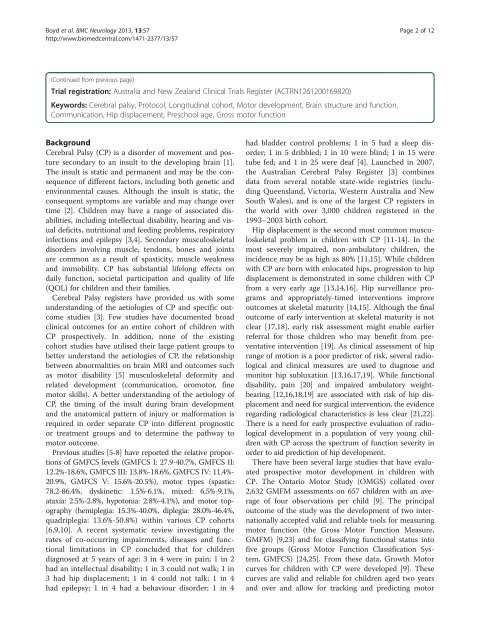Australian Cerebral Palsy Child Study: protocol of ... - BioMed Central
Australian Cerebral Palsy Child Study: protocol of ... - BioMed Central
Australian Cerebral Palsy Child Study: protocol of ... - BioMed Central
Create successful ePaper yourself
Turn your PDF publications into a flip-book with our unique Google optimized e-Paper software.
Boyd et al. BMC Neurology 2013, 13:57 Page 2 <strong>of</strong> 12<br />
http://www.biomedcentral.com/1471-2377/13/57<br />
(Continued from previous page)<br />
Trial registration: Australia and New Zealand Clinical Trials Register (ACTRN1261200169820)<br />
Keywords: <strong>Cerebral</strong> palsy, Protocol, Longitudinal cohort, Motor development, Brain structure and function,<br />
Communication, Hip displacement, Preschool age, Gross motor function<br />
Background<br />
<strong>Cerebral</strong> <strong>Palsy</strong> (CP) is a disorder <strong>of</strong> movement and posture<br />
secondary to an insult to the developing brain [1].<br />
The insult is static and permanent and may be the consequence<br />
<strong>of</strong> different factors, including both genetic and<br />
environmental causes. Although the insult is static, the<br />
consequent symptoms are variable and may change over<br />
time [2]. <strong>Child</strong>ren may have a range <strong>of</strong> associated disabilities,<br />
including intellectual disability, hearing and visual<br />
deficits, nutritional and feeding problems, respiratory<br />
infections and epilepsy [3,4]. Secondary musculoskeletal<br />
disorders involving muscle, tendons, bones and joints<br />
are common as a result <strong>of</strong> spasticity, muscle weakness<br />
and immobility. CP has substantial lifelong effects on<br />
daily function, societal participation and quality <strong>of</strong> life<br />
(QOL) for children and their families.<br />
<strong>Cerebral</strong> <strong>Palsy</strong> registers have provided us with some<br />
understanding <strong>of</strong> the aetiologies <strong>of</strong> CP and specific outcome<br />
studies [3]. Few studies have documented broad<br />
clinical outcomes for an entire cohort <strong>of</strong> children with<br />
CP prospectively. In addition, none <strong>of</strong> the existing<br />
cohort studies have utilised their large patient groups to<br />
better understand the aetiologies <strong>of</strong> CP, the relationship<br />
between abnormalities on brain MRI and outcomes such<br />
as motor disability [5] musculoskeletal deformity and<br />
related development (communication, oromotor, fine<br />
motor skills). A better understanding <strong>of</strong> the aetiology <strong>of</strong><br />
CP, the timing <strong>of</strong> the insult during brain development<br />
and the anatomical pattern <strong>of</strong> injury or malformation is<br />
required in order separate CP into different prognostic<br />
or treatment groups and to determine the pathway to<br />
motor outcome.<br />
Previous studies [5-8] have reported the relative proportions<br />
<strong>of</strong> GMFCS levels (GMFCS I: 27.9-40.7%, GMFCS II:<br />
12.2%-18.6%, GMFCS III: 13.8%-18.6%, GMFCS IV: 11.4%-<br />
20.9%, GMFCS V: 15.6%-20.5%), motor types (spastic:<br />
78.2-86.4%, dyskinetic: 1.5%-6.1%, mixed: 6.5%-9.1%,<br />
ataxia: 2.5%-2.8%, hypotonia: 2.8%-4.1%), and motor topography<br />
(hemiplegia: 15.3%-40.0%, diplegia: 28.0%-46.4%,<br />
quadriplegia: 13.6%-50.8%) within various CP cohorts<br />
[6,9,10]. A recent systematic review investigating the<br />
rates <strong>of</strong> co-occurring impairments, diseases and functional<br />
limitations in CP concluded that for children<br />
diagnosed at 5 years <strong>of</strong> age: 3 in 4 were in pain; 1 in 2<br />
had an intellectual disability; 1 in 3 could not walk; 1 in<br />
3 had hip displacement; 1 in 4 could not talk; 1 in 4<br />
had epilepsy; 1 in 4 had a behaviour disorder; 1 in 4<br />
had bladder control problems; 1 in 5 had a sleep disorder;1in5dribbled;1in10wereblind;1in15were<br />
tube fed; and 1 in 25 were deaf [4]. Launched in 2007,<br />
the <strong>Australian</strong> <strong>Cerebral</strong> <strong>Palsy</strong> Register [3] combines<br />
data from several notable state-wide registries (including<br />
Queensland, Victoria, Western Australia and New<br />
South Wales), and is one <strong>of</strong> the largest CP registers in<br />
the world with over 3,000 children registered in the<br />
1993–2003 birth cohort.<br />
Hip displacement is the second most common musculoskeletal<br />
problem in children with CP [11-14]. In the<br />
most severely impaired, non-ambulatory children, the<br />
incidence may be as high as 80% [11,15]. While children<br />
with CP are born with enlocated hips, progression to hip<br />
displacement is demonstrated in some children with CP<br />
from a very early age [13,14,16]. Hip surveillance programs<br />
and appropriately-timed interventions improve<br />
outcomes at skeletal maturity [14,15]. Although the final<br />
outcome <strong>of</strong> early intervention at skeletal maturity is not<br />
clear [17,18], early risk assessment might enable earlier<br />
referral for those children who may benefit from preventative<br />
intervention [19]. As clinical assessment <strong>of</strong> hip<br />
range <strong>of</strong> motion is a poor predictor <strong>of</strong> risk, several radiological<br />
and clinical measures are used to diagnose and<br />
monitor hip subluxation [13,16,17,19]. While functional<br />
disability, pain [20] and impaired ambulatory weightbearing<br />
[12,16,18,19] are associated with risk <strong>of</strong> hip displacement<br />
and need for surgical intervention, the evidence<br />
regarding radiological characteristics is less clear [21,22].<br />
There is a need for early prospective evaluation <strong>of</strong> radiological<br />
development in a population <strong>of</strong> very young children<br />
with CP across the spectrum <strong>of</strong> function severity in<br />
order to aid prediction <strong>of</strong> hip development.<br />
There have been several large studies that have evaluated<br />
prospective motor development in children with<br />
CP. The Ontario Motor <strong>Study</strong> (OMGS) collated over<br />
2,632 GMFM assessments on 657 children with an average<br />
<strong>of</strong> four observations per child [9]. The principal<br />
outcome <strong>of</strong> the study was the development <strong>of</strong> two internationally<br />
accepted valid and reliable tools for measuring<br />
motor function (the Gross Motor Function Measure,<br />
GMFM) [9,23] and for classifying functional status into<br />
five groups (Gross Motor Function Classification System,<br />
GMFCS) [24,25]. From these data, Growth Motor<br />
curves for children with CP were developed [9]. These<br />
curves are valid and reliable for children aged two years<br />
and over and allow for tracking and predicting motor
















